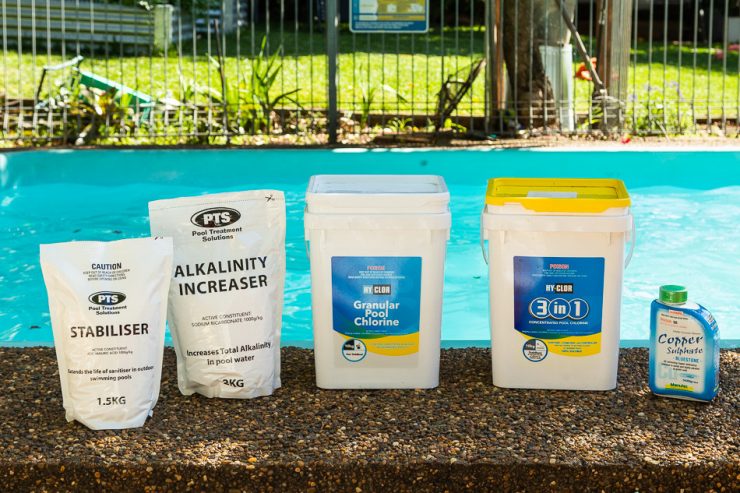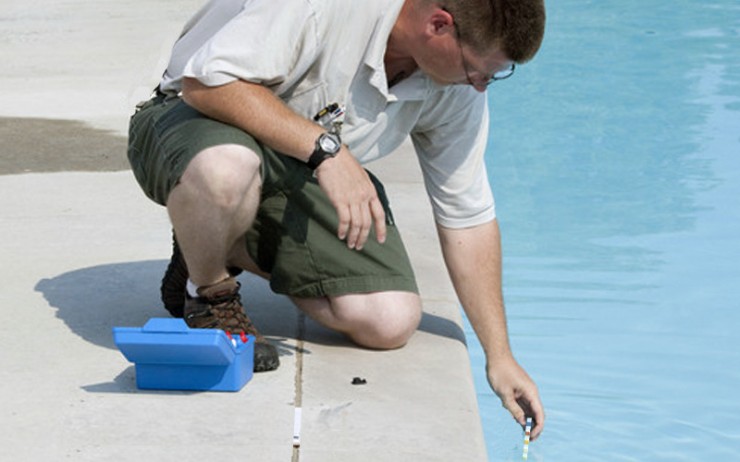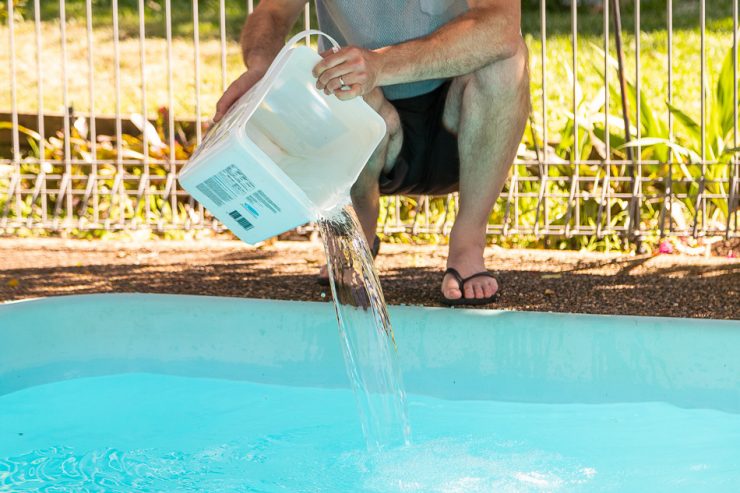When it comes to taking care of your pool and keeping your chemicals balanced or opening your pool after winter, it can be hard to know what chemicals you should add and when. Does it really matter what order you add the pool chemicals in?
There is in fact a correct order to add your pool chemicals in after opening your pool or even just maintaining your pool. And the order you use them will actually depend on what you need to accomplish with your pool.
An important part of the process will be to test the pool water and then work to balance out the levels according to the details of your testing. There are standard steps that you should follow with adding chemicals.
Let’s dig a little deeper on this topic so you can know exactly what order your pool chemicals need to be added in.

Article Contents
The Correct Order To Add Pool Chemicals
We’ve outlined below the very best order that you can follow to add your pool chemicals for the perfect balance. If you follow these steps and directions, you should have no problems in the end.
Getting the hang of the process and understanding what your pool needs may take a little bit of time but you will get it. Just stick to the basic order and work from there.
Here is a quick review of the order to add chemicals when opening or adjusting your pool:
- Alkalinity
- pH Levels
- Calcium Hardness
- Stabilizer
- Chlorine
Why is it Important to Add Chemicals in the Right Order?
Can you just randomly add your chemicals and never really know that it might be wrong? Well, sure but that doesn’t mean that’s an effective strategy to manage your pool. It might mean that you are wasting chemicals or even perhaps harming your water more than helping it or constantly fighting with your pool to balance it.
The pool is meant for playing and sunbathing so you want to make it a happy place to spend time in, right?
Balancing your pool chemicals and adding them in the right order makes it easier for you to maintain, safe for swimmers but it also protects your pool materials and equipment as well.
Related Reading: Can You Add Pool Chemicals All At Once? (answered!)
What Happens When You Add Chemicals in the Wrong Order?
Adding chemicals in the wrong order can lead to imbalances of chemicals and might actually make your pool issues worse or cause one chemical to be ineffective because of the combination or the way that the chemicals work.
You have to reach a balance with certain areas and follow a process meant to correct water imbalances. If you just toss chemicals in no particular order, it will make it much more difficult to balance your water and ultimately, it will likely cost you more money.
Remember that not all chemicals mix so while you still might add both of those chemicals to the pool, how you do it will definitely make a difference.
What Chemicals to Add When & Why
Below is a detailed look at what order you should add the pool chemicals and why it’s important to do this. This methodology covers opening your pool after winter and also regular maintenance.
If you are opening your pool after winter, you might want to check out:
How To Open An Inground Swimming Pool In 8 Steps
1. Start by Testing Your Water
- Tests total alkalinity, free/combined chlorine, cyanuric acid, calcium hardness & pH
- Extremely accurate (better than test strips)
- For pools & spas
The first thing that you should do before you start adding chemicals is test the water. You also want to make sure you’ve got your pump on as that will help to circulate the chemicals throughout the pool.
Most experts recommend testing pool water 1-2 times per week.
As you test and wait for the results, you can get your supplies ready for adding chemicals. You’ll also need to know your pool volume.
The easiest way to calculate your volume is to use a pool volume calculator like this one.
Your test kit should cover chlorine, cyanuric acid (aka stabilizer), pH, alkalinity, and calcium hardness.
2. Alkalinity Levels
To start, you need to address the alkalinity of your pool. You should know your levels based on the test you performed before you started. This is the first thing to do once you’ve tested the water.
You do this before messing with your pH because alkaline is considered to be a pH stabilizer or buffer. What you add for adjusting the alkalinity will depend on whether you need to increase or decrease alkalinity.
Standard alkaline levels should be between 80-120 PPM.
- To decrease alkalinity try adding dry acid (sodium bisulfate) or muriatic acid
- To increase alkalinity try adding baking soda (sodium bicarbonate)
3. Manage pH Levels: Add Muriatic Acid of Soda Ash
If you’ve ever swum in a pool and then your eyes or your skin burned while you were swimming or even after swimming, it’s probably because the pH levels were off in the pool. pH is for the comfort of the swimmer.
In addition to this, chlorine is not as effective if the pH levels are not right. And finally, incorrect pH levels can increase pool equipment corrosion.
You might want to test your pH after you’ve got your alkalinity settled so you know just what you need to do. pH ranges from 1.0 to 14.0 on the scale. The perfect range to be in is between 7.4 and 7.6.
- To decrease pH, use sodium bisulfate or muriatic acid
- To increase pH, use sodium carbonate (baking soda) or soda ash (best)

4. Adjust the Calcium Hardness
Calcium can build up around the edges of your pool and will be noticeable because of discoloration. As well as making your pool look dirty, it can also cause damage to the equipment as well as the pool structure.
The best range for calcium hardness is 200-400 PPM.
- To decrease calcium hardness, add fresh water to the pool
- You may need to partially drain your pool and then top up with fresh water to remove calcium. Also, you should brush your pool and then vacuum it to remove excess calcium
- To increase calcium hardness, add calcium chloride. Be sure to follow all manufacturer’s instructions.
5. Add Stabilizer (Cyanuric Acid)
Next is stabilizer. Stabilizer is cyanuric acid. It’s important that you get this right BEFORE adjusting the chlorine levels. The right level of stabilizer basically makes the chlorine you add more effective and helps it last longer.
When you add chlorine, the UV rays of the sun actually burn it off so stabilizer works to prevent that from happening, or at least slow it down. Not enough stabilizer and your chlorine will dissipate quickly and not be effective.
Your chlorine may already include stabilizer so be sure to check that detail as well. We recommend chlorine without stabilizer so you can control the stabilizer levels separately.
Ideally, stabilizer should be between 30-50 PPM.
If the stabilizer is too high, it will prevent the chlorine from working effectively and you’ll actually need a lot more to do the same job. You can reduce it by draining a little water from the pool and topping it up with fresh water to dilute it.
If the stabilizer is too low, you can add some cyanuric acid or use a stabilized chlorine like Trichlor for a little while.
After you have the stabilizer levels in order, you can move on to the next thing.
6. Add Chlorine
Finally, once you’ve settled gotten all the other chemical levels right, you should be able to add your chlorine. This is a sanitizer for the pool and helps to keep the pool clean and sanitary for multiple swimmers.
It’s important that you do not adjust the chlorine levels unless the other levels are correct, particularly the pH and stabilizer. If the pH and stabilizer are not correct, your chlorine will lose effectiveness. In some cases you may need triple the amount of chlorine to have the same sanitizer effect.
Having correct pH and stabilizer levels means you will save you money on chlorine.
You can find chlorine in many different forms, including tablets, liquid, granular, or in the case of a saltwater pool, it uses a salt chlorine generator to make chlorine. There is also pool shock, which is a chlorine that works quickly to sanitize the pool.
Your test should be able to pinpoint free chlorine values. Since you’ve worked to balance everything else out already, you may want to test just the chlorine at this stage to know where to adjust it.
Chlorine levels should ideally be 3-5 PPM.
Shocking the Pool
You may not need to shock your pool but if you feel like there is a little algae or it’s particularly dirty (like after heavy rain or heavy bather use), you can shock your pool. It is best to dissolve your pool shock into a bucket of water and then slowly pour it in all over the pool instead of just dumping it in.
It’s always best to shock your pool when the sun goes down to avoid the chlorine burning off in the UV light.
Related Reading: Which Pool Shock Should You Use? (answered!)
Can You Add All of Your Chemicals at Once?

You should never add all of your chemicals at the same time. This needs to be done in a process and may actually be completed over the span of a day or two.
There are two reasons why:
- Adding all of your pool chemicals at once can cause dangerous chemical, even potentially causing an explosion from the chemicals. You should never mix chemicals together.
- It’s best to add chemicals slowly. By doing this you will avoid seesawing the chemical levels which can happen if you make large adjustments at once. What you want to do instead is add smaller amounts of chemicals, retest the water to see the impact of the adjustment, and add more chemicals if necessary.
Conclusion
Adding pool chemicals in the correct order is a must when maintaining your swimming. Always make sure the pH and stabilizer levels are correct before adding more chlorine. These will have the biggest impact on maintaining clean and clear pool water.


